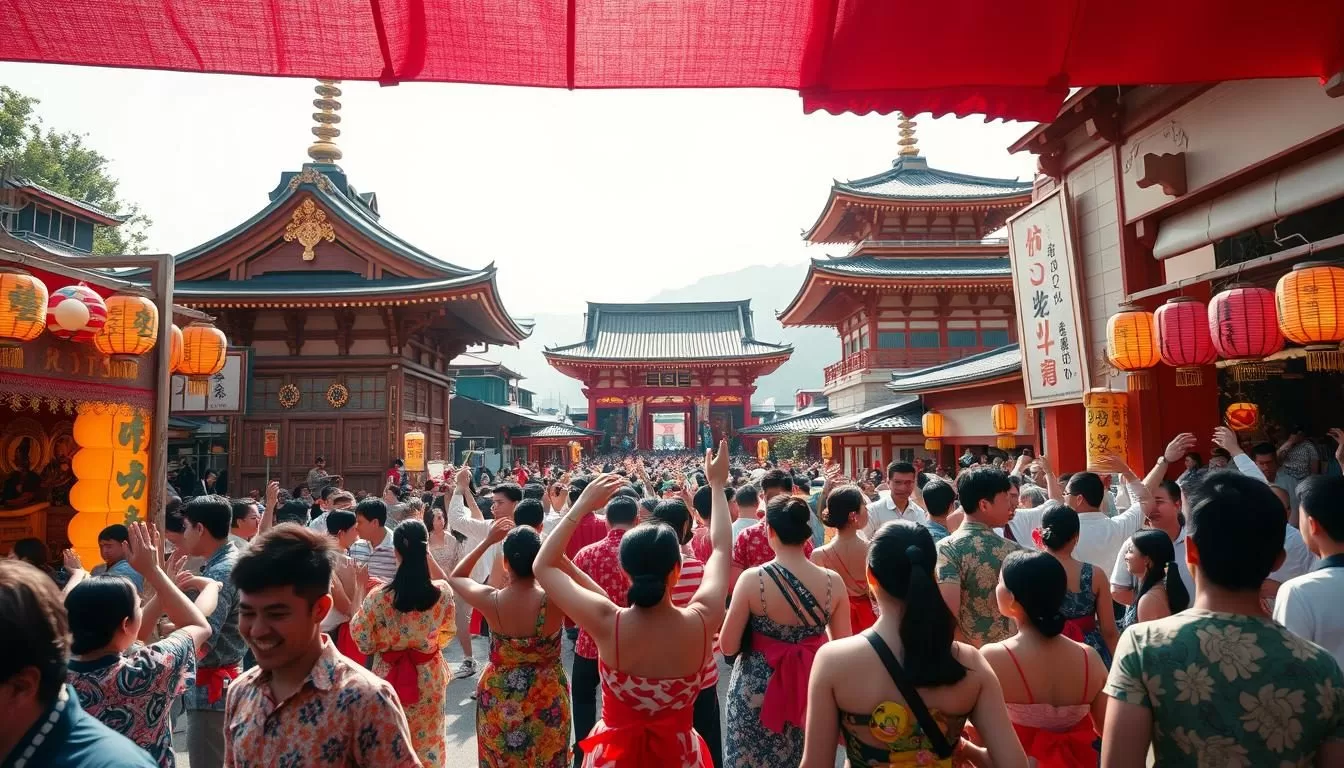✓ Accommodations✓ Flights✓ Rental Cars
As you plan your trip to Kyoto Prefecture, you’re likely to be drawn to its rich culture and vibrant traditions. This region is renowned for its spectacular events and festivals that showcase Japan’s heritage.
You’ll have the opportunity to experience centuries of history and community spirit firsthand by attending one of the many celebrations that take place throughout the year. From grand historical processions to intimate spiritual ceremonies, Kyoto’s festival calendar is filled with unique and unforgettable experiences.
By exploring the best times to visit and the most significant events, you’ll be able to plan your trip to coincide with the festivals that match your interests, whether you’re drawn to spiritual traditions, historical reenactments, or vibrant street celebrations.
The Cultural Significance of Kyoto’s Festival Heritage
As you explore Kyoto’s festival heritage, you’ll discover a unique blend of ancient customs and modern celebrations. Kyoto’s festivals are deeply tied to Japan’s religious and cultural traditions, with many events originating as rituals to honor deities or mark seasonal changes.
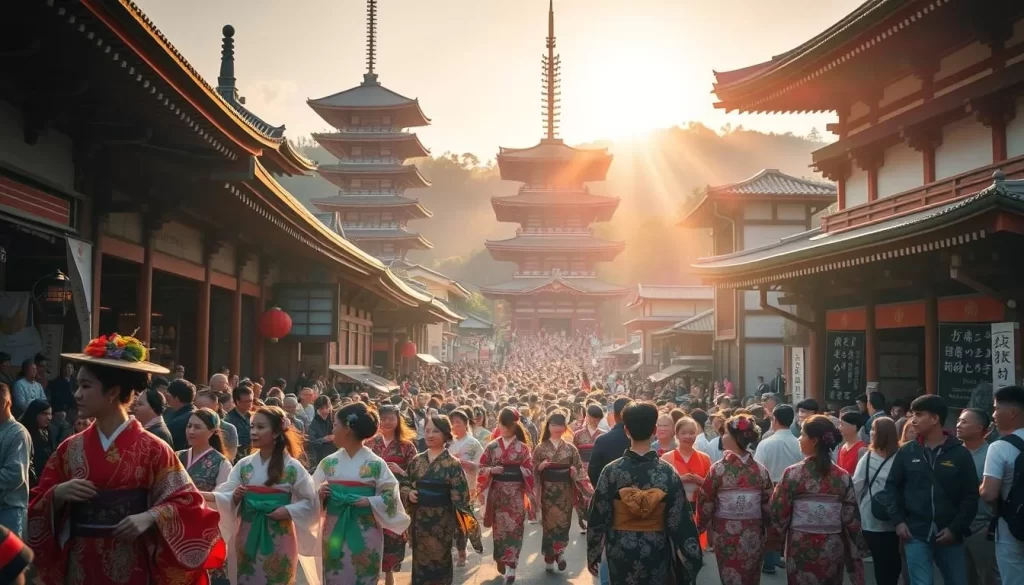
A Window into Kyoto’s Cultural Soul
Kyoto’s festivals serve as a window into the city’s cultural soul, offering a glimpse into its rich history and the experience of its people. You’ll see how these events preserve ancient customs while adapting to contemporary society. The festivals create a unique space where you can experience living history, as locals don centuries-old costumes and perform rituals established during Japan’s imperial era.
How Festivals Connect Past and Present
These events not only reflect Kyoto’s historical role as the cultural and political center of Japan but also strengthen community bonds. Preparation for the festivals often involves entire neighborhoods working together for months, fostering a sense of unity among the people. You’ll discover how Kyoto’s festivals incorporate elements that have been preserved over time, making them a significant part of the city’s culture in the modern world. Many festivals also offer a rare opportunity to witness traditional arts like Noh theater, court music (gagaku), and traditional dance continue to thrive in their original cultural context.
By participating in or observing these events, you’ll gain a deeper understanding of Kyoto’s cultural heritage and its significance in contemporary society.
Kyōto Prefecture, Japan: Top Festivals to Check Out When Visiting
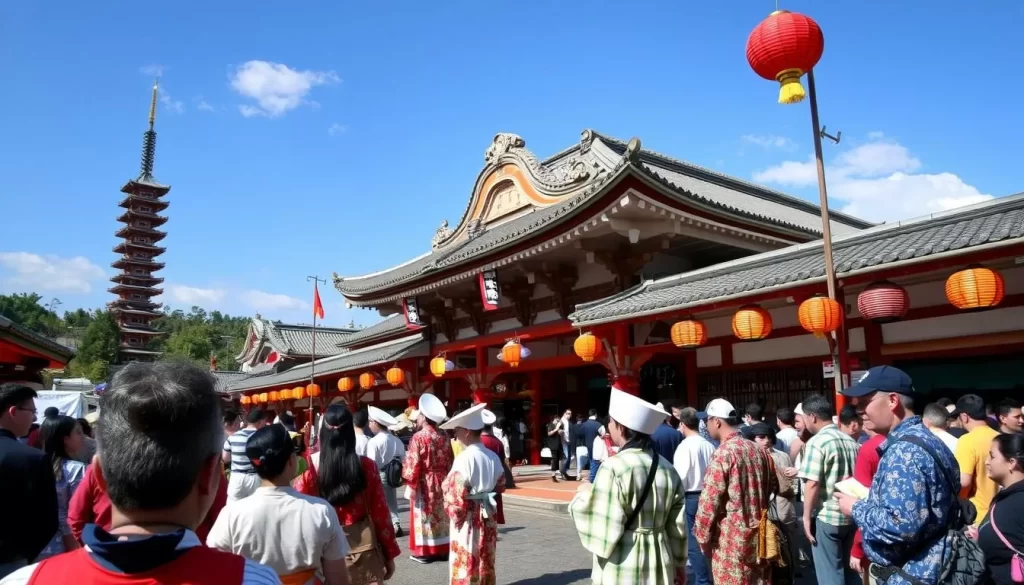
Kyoto’s rich cultural heritage is perhaps best showcased through its vibrant festivals and events. These celebrations offer a unique experience that blends centuries-old traditions with contemporary trends, making them a must-see for any visitor.
Why Kyoto’s Festivals Stand Out in Japan
Kyoto’s festivals are renowned for their grandeur and cultural significance. You’ll find that these events are meticulously organized, reflecting the city’s deep respect for its heritage. The festivals provide a rare glimpse into traditional performing arts, including ancient court dances and music, which are seldom performed outside these special occasions.
The unique sensory aspects of Kyoto’s celebrations are not to be missed. From the distinctive aromas of festival foods to the sounds of traditional instruments and chants, these events create a complete immersive experience.
What Makes These Celebrations a Must-See Experience
Kyoto’s festivals offer you authentic cultural engagement beyond typical tourist experiences. You’ll have the chance to interact with locals who take immense pride in sharing their heritage. The festivals also provide unparalleled photographic opportunities, with vivid colors, dramatic processions, and atmospheric lighting that create unforgettable visual memories.
Moreover, many sacred spaces, including temples and shrines, open exclusively during celebration periods, giving you access to normally restricted areas. This unique access, combined with the rich culture and traditions on display, makes visiting Kyoto during festival time an unforgettable experience.
The Three Major Festivals of Kyoto
Kyoto’s rich cultural tapestry is woven with numerous festivals, among which three major celebrations hold a special place in the hearts of locals and visitors alike. These events are not just entertaining spectacles but also serve as a window into the city’s history and cultural traditions. They offer a unique experience that allows you to immerse yourself in Kyoto’s heritage.
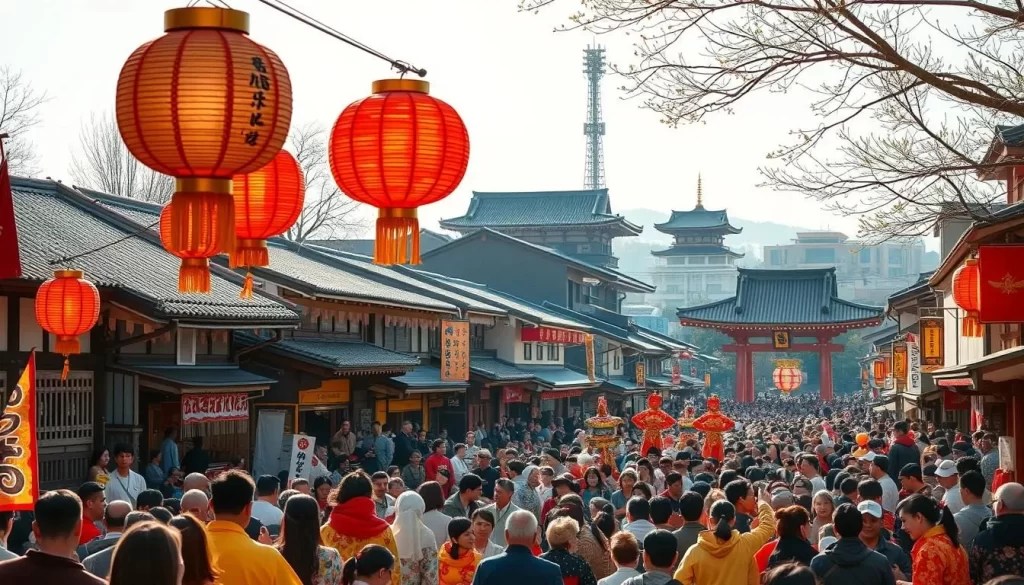
Aoi Matsuri: Ancient Traditions in Bloom
The Aoi Matsuri, held on May 15th, is one of Kyoto’s most revered festivals, showcasing the city’s ability to preserve its traditions amidst modern life. This ancient celebration, dating back to the 8th century, is characterized by a grand procession of people dressed in Heian-era costumes, making their way from the Imperial Palace to the Shimogamo and Kamigamo Shrines. The event is a testament to Kyoto’s enduring cultural heritage.
As you watch the procession, you’ll be struck by the attention to detail in the participants’ attire and the serene atmosphere that pervades the event. The Aoi Matsuri is a must-see experience for anyone interested in Japan’s cultural history and traditional events.
Gion Festival: A Month-Long Summer Celebration
The Gion Festival, taking place throughout July, is Kyoto’s most famous festival, attracting visitors from around the world. The highlight of the event is the Yamaboko Junko parade, where elaborate floats are pulled through the streets of Kyoto’s Gion district. This parade is a spectacle of color and sound, with the floats adorned with intricate carvings and costumes that reflect Kyoto’s rich cultural heritage.
As you enjoy the Gion Festival, you’ll have the opportunity to experience the city’s vibrant culture firsthand. The event is a celebration of Kyoto’s history and traditions, offering a unique glimpse into the city’s past and present.
Jidai Matsuri: A Living History Lesson
The Jidai Matsuri, held on October 22nd, is a living history lesson that commemorates the founding of Kyoto. The festival features a grand parade of over 2,000 participants dressed in costumes representing different historical periods, from the Heian era to the Meiji Restoration. As you watch the procession, you’ll be treated to a visual journey through Kyoto’s history, with each costume and prop meticulously recreated to represent a specific era.
This festival is an educational experience that allows you to step back in time and explore Kyoto’s rich cultural heritage. The Jidai Matsuri is a testament to the city’s commitment to preserving its history and traditions for future generations.
Spring Festivals: Cherry and Plum Blossom Celebrations
The arrival of spring in Kyoto signals the beginning of a festive season, with cherry and plum blossom celebrations taking center stage. As the city awakens from its winter slumber, the beauty of nature is celebrated through various events and festivals.
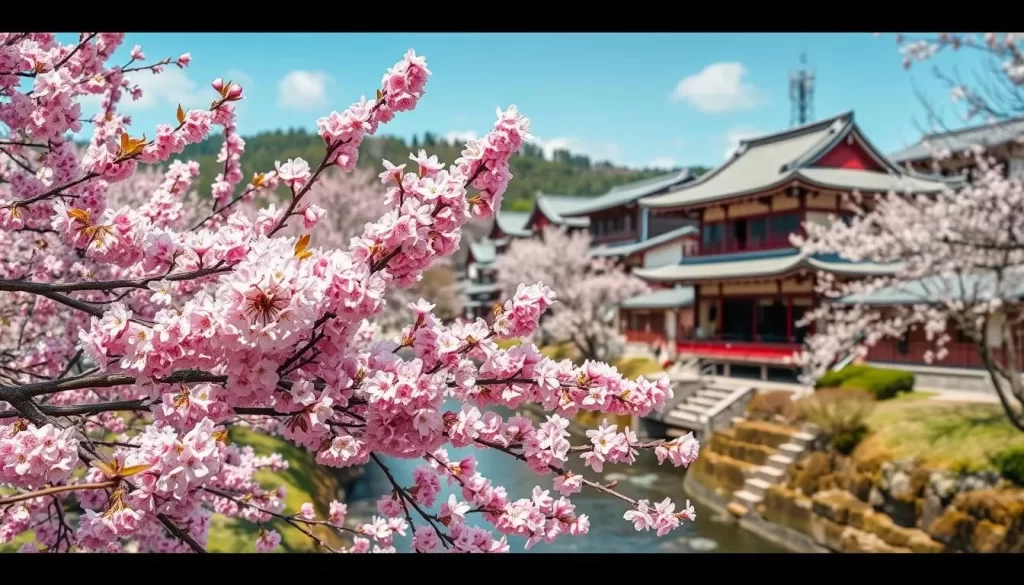
Hirano Shrine Cherry Blossom Festival
The Hirano Shrine Cherry Blossom Festival is a cherished spring tradition, attracting visitors from around the world. The shrine’s grounds are home to a variety of cherry blossom trees, creating a picturesque landscape.
During the festival, you can enjoy the beauty of the blossoms while experiencing traditional Japanese culture. The serene atmosphere of the shrine provides a perfect backdrop for events such as traditional tea ceremonies and local performances.
Kitano Tenmangu Plum Blossom Festival
The Kitano Tenmangu Shrine hosts a renowned Plum Blossom Festival, celebrating over 900 years of tradition. The plum trees, numbering around 2,000 in 50 varieties, create a stunning display from late February through March, offering a less crowded alternative to cherry blossom viewing.
You’ll have the opportunity to experience special events such as traditional tea ceremonies among the blossoming plum trees, and learn about the cultural significance of plum blossoms in Japanese history. The festival also features weekend cultural performances, enhancing your appreciation of this seasonal celebration.
Summer Festival Highlights in Kyoto
As summer arrives in Kyoto, the city comes alive with festivals that showcase its rich traditions. The summer season in Kyoto is a time of vibrant events that blend ancient rituals with modern celebrations, offering visitors a unique experience.
Gion Matsuri: Yamaboko Junko Parade and Yoiyama Evenings
The Gion Matsuri is one of Kyoto’s most famous festivals, taking place throughout July. The highlight is the Yamaboko Junko Parade, where elaborate floats are paraded through the streets. The evenings leading up to the parade, known as Yoiyama, are filled with festivities, including traditional food stalls and live music.
During Yoiyama, the atmosphere is electric, with locals and visitors alike enjoying the ceremony-like ambiance. The floats are decorated with intricate designs, and the streets are filled with people in traditional attire, creating a truly immersive experience.
Mitarashi Matsuri and Nagoshi no Harae Purification Rituals
In late July, the Mitarashi Matsuri at Shimogamo Shrine offers a unique purification ritual. Visitors wade through a shallow pool of purifying water while holding candles, creating a magical nighttime scene. This ceremony is believed to cleanse both body and spirit, preparing participants for the second half of the year.
| Festival | Date | Description |
|---|---|---|
| Gion Matsuri | July | Yamaboko Junko Parade and Yoiyama Evenings |
| Mitarashi Matsuri | Late July | Purification ritual at Shimogamo Shrine |
| Nagoshi no Harae | June 30th | Purification ritual at various shrines |
The Nagoshi no Harae rituals, held on June 30th at various shrines throughout Kyoto, involve passing through large grass rings (chinowa) as a symbolic act of purification. These events date back to the Nara period and offer insight into ancient Japanese beliefs about spiritual cleanliness.
Autumn Festivals and Cultural Events
As autumn descends upon Kyoto, the city comes alive with vibrant festivals and cultural events that showcase its rich heritage. The autumn season offers a unique opportunity to experience Kyoto’s traditions, from historical processions to spectacular fire festivals.
Jidai Matsuri: Historical Processions and Period Costumes
Jidai Matsuri, or the “Festival of Ages,” is a spectacular event that takes you on a journey through Kyoto’s rich history. This festival features a grand procession of people dressed in period costumes, representing different eras of Japanese history. You’ll witness the grandeur of samurai armor, the elegance of court nobility, and the vibrant colors of traditional clothing, all blending together in a spectacular display of Kyoto’s cultural heritage.
The festival culminates at the Kyoto Imperial Palace, where you can experience the splendor of traditional Japanese culture. With its historical significance and visual spectacle, Jidai Matsuri is an unforgettable experience that offers insights into Kyoto’s past.
Kurama Fire Festival: A Night of Blazing Torches
The Kurama Fire Festival is one of Japan’s most dramatic fire festivals, held on October 22nd in the mountain village of Kurama. You’ll witness hundreds of local men and children carrying flaming torches of various sizes through the village streets, creating a spectacular scene of fire against the night sky. As the energy builds toward midnight, massive torches are carried to Yuki Shrine at the top of the village, offering a raw and exhilarating experience.
This ancient festival, dating back to the 10th century, commemorates the relocation of Yuki Shrine to Kurama. It provides a rare glimpse into rural Japanese festival traditions, contrasting with the more formal celebrations in central Kyoto. The Kurama Fire Festival is a unique celebration that showcases the area’s long spiritual history and cultural heritage.
Winter Festivals and New Year Celebrations
Experience Kyoto’s enchanting winter festivals and New Year celebrations, a perfect blend of tradition and festivity. As the year comes to a close, Kyoto transforms into a vibrant cultural hub, offering unique events and experiences that showcase the city’s rich heritage.
Setsubun Festival at Yasaka Shrine
The Setsubun Festival at Yasaka Shrine is a significant event that marks the beginning of spring according to the lunar calendar. It’s a time when people gather to cast away evil spirits and welcome good fortune. The festival is characterized by the throwing of roasted soybeans, a ritual believed to ward off evil and bring good luck. Visitors can participate in this lively tradition, experiencing the festive atmosphere and the shrine’s vibrant decorations.
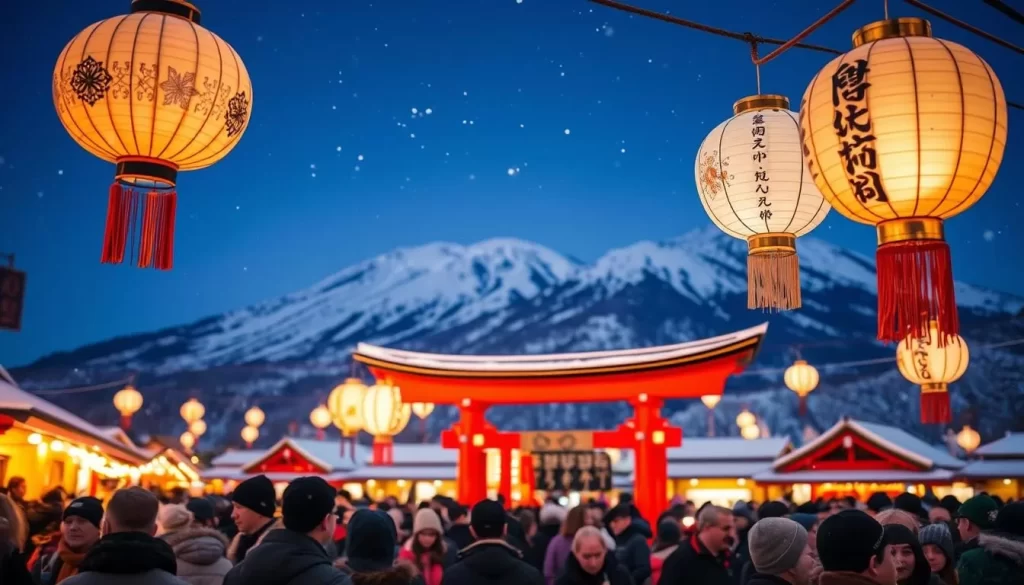
Hatsumode: First Shrine Visits of the New Year
Hatsumode is a cherished tradition where people visit shrines or temples for the first time in the New Year to pray for safety, peace, and good fortune. In Kyoto, popular shrines like Fushimi Inari Taisha, Yasaka Shrine, and Heian Shrine attract millions of visitors. At these shrines, you can participate in various New Year’s rituals, such as purchasing new omamori (protective charms), writing ema (wooden prayer plaques), and drawing omikuji (fortune papers). The shrines are beautifully decorated with shimenawa (sacred ropes) and kadomatsu (pine decorations), creating a festive and serene atmosphere. Enjoy the special New Year’s food stalls offering seasonal treats like amazake (sweet fermented rice drink) and other street foods that warm the spirit during the winter celebration.
As you join the millions of people in this significant event, you’ll be immersed in a unique cultural experience that highlights the spiritual and communal aspects of Kyoto’s New Year celebrations.
Spiritual Aspects of Kyoto’s Festival Traditions
As you explore Kyoto’s festivals, you’ll discover a rich tapestry of spiritual practices and traditions that have been woven into the fabric of the city’s culture. These spiritual events are not just celebrations; they’re a way to connect with the city’s heritage and experience its deep-rooted traditions.
Shinto Shrine Rituals and Sacred Ceremonies
Kyoto’s Shinto shrines are at the heart of many festivals, hosting sacred ceremonies that have been performed for centuries. These rituals are an integral part of the Shinto tradition, offering a glimpse into the spiritual practices that shape the city’s identity. You can witness these sacred ceremonies firsthand, experiencing the devotion and reverence that define Kyoto’s festival culture.
The rituals performed at Shinto shrines are diverse, ranging from purification rites to ceremonial processions. Each event is a testament to the enduring power of Shinto traditions in Kyoto.
Temple Celebrations and Buddhist Traditions
Buddhist temples also play a significant role in Kyoto’s festival landscape, hosting various celebrations that reflect the city’s Buddhist heritage. Events like the Manto-e at Daigoji Temple, featuring thousands of lanterns, create a serene and mystical atmosphere, symbolizing the spiritual connection between the community and the temple.
| Festival/Event | Location | Spiritual Significance |
|---|---|---|
| Manto-e | Daigoji Temple | Lantern ceremony symbolizing spiritual connection |
| Omizutori | Nigatsudo Hall, Todaiji Temple | Fire ritual marking renewal and purification |
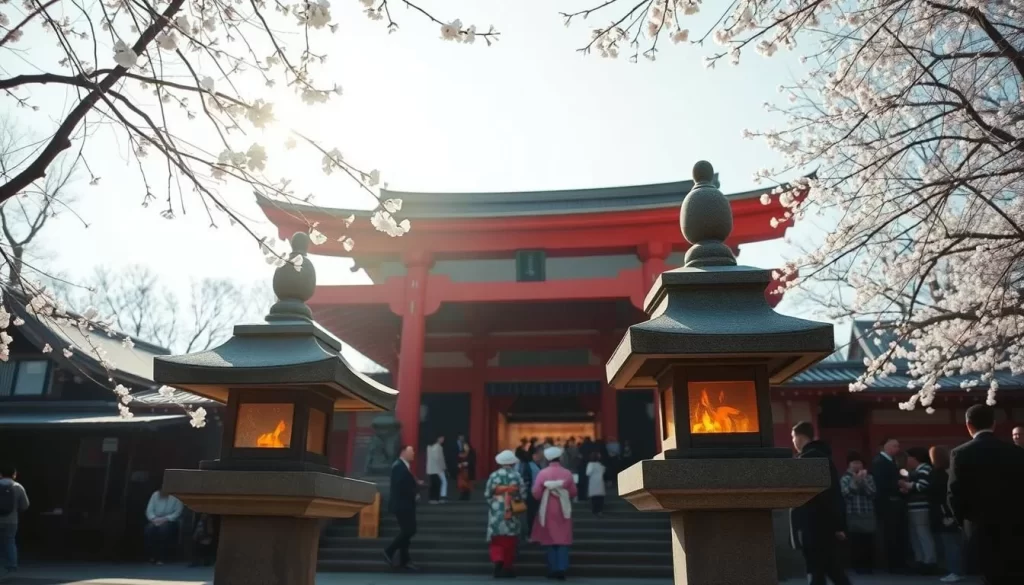
These temple celebrations and Buddhist traditions offer a unique experience, allowing you to participate in or witness ancient rituals that continue to shape Kyoto’s spiritual identity.
Lesser-Known Festivals Worth Experiencing
Delving deeper into Kyoto’s cultural landscape reveals a wealth of lesser-known festivals and events that offer a unique experience of the city’s rich cultural heritage. These events provide a fascinating glimpse into traditional Japanese culture and are definitely worth experiencing.
Misogi Matsuri: The Foot-Washing Ritual at Shimogamo Shrine
One such tradition is the Misogi Matsuri, held at Shimogamo Shrine. This unique ritual involves a foot-washing ceremony that dates back to ancient times. Originally practiced by nobility, it’s now open to everyone, offering a hands-on way to connect with the spirit of the event. The ceremony is a form of purification, symbolizing the cleansing of the body and mind. Participants wash their feet in the shrine’s sacred waters, a practice that’s both meditative and spiritually enriching.
Unique Bull Processions: Imamiya Yasurai and Uzumasa Ushi Matsuri
Kyoto also hosts some extraordinary processions, such as the Imamiya Yasurai festival in mid-April and the Uzumasa Ushi Matsuri in October. The Imamiya Yasurai festival features a sacred bull leading a procession of participants in distinctive black-and-white striped costumes and unique cone-shaped hats. The festival includes hypnotic dance movements and music believed to ward off illness and bring good health.
| Festival Name | Date | Key Features |
|---|---|---|
| Imamiya Yasurai | Mid-April | Sacred bull procession, traditional dance and music |
| Uzumasa Ushi Matsuri | October | Decorated bull carrying a “divine child” |
| Misogi Matsuri | Specific date not mentioned | Foot-washing ritual, purification ceremony |
These events not only showcase Kyoto’s rich cultural diversity but also offer visitors a chance to participate in meaningful celebrations that are off the beaten path.
Spectacular Fire Festivals and Night Illuminations
Kyoto’s fire festivals are a breathtaking display of tradition and spirituality, illuminating the night sky. These events are a culmination of the city’s rich cultural heritage, offering a unique experience that combines ritual, culture, and celebration.
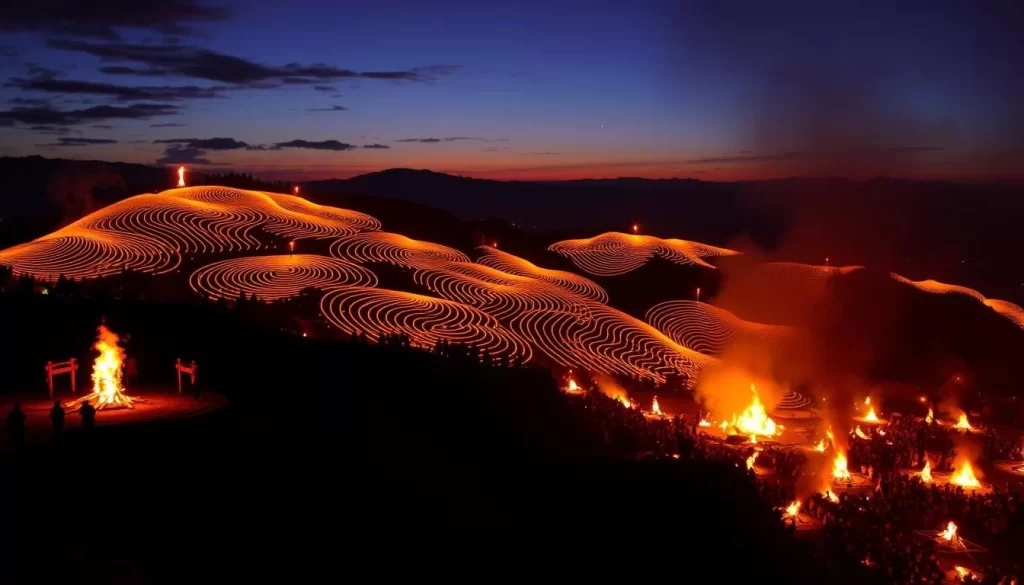
Gozan Okuribi: The Five Mountain Fires
The Gozan Okuribi, held in mid-August, is a mesmerizing display that lights up the night sky with five massive bonfires on mountain slopes surrounding Kyoto. You’ll experience the culmination of Kyoto’s Obon season on August 16th, as these fires are lit in sequence, starting at 8:00 PM.
The fires form specific shapes, including the character ” ” (dai) on Daimonji mountain, followed by other shapes at approximately five-minute intervals. Each shape holds spiritual significance, representing the guiding of ancestral spirits back to the spirit world.
Daimonji Gozan Okuribi: Sending Off Ancestral Spirits
Daimonji Gozan Okuribi is an integral part of the Gozan Okuribi event, symbolizing the moment when ancestral spirits are sent back to the spirit world. This tradition, dating back to the Edo period, is maintained by local neighborhood associations who prepare the firewood, create the shapes, and light the fires in a coordinated effort.
You’ll witness the community’s dedication to preserving this ancient ritual, as the fires create a dramatic and unforgettable experience against the dark night sky. The sight is both awe-inspiring and deeply spiritual, offering a unique way to connect with Kyoto’s heritage.
Historical Processions That Bring Kyoto’s Past to Life
As you explore Kyoto’s festivals, you’ll discover historical processions that vividly recreate the city’s heritage. These events are a testament to Kyoto’s rich cultural legacy and its people’s dedication to preserving their history.
Reenactments and Period Costumes
The Jidai Matsuri, held annually on October 22, is a prime example of Kyoto’s historical processions. This festival features a grand procession of over 2,000 participants dressed in costumes representing different historical periods, from the Meiji Restoration to the Heian era. The meticulous preparation and artistic effort behind these displays are evident in every costume and prop, crafted by local artisans using traditional techniques to ensure authenticity and cultural accuracy.
| Era | Costume Characteristics | Props |
|---|---|---|
| Meiji Restoration | Western-style clothing with traditional Japanese elements | Modern firearms, traditional swords |
| Heian Era | Intricate court dress, layered kimonos | Traditional fans, ceremonial staffs |
Traditional Music and Dance Performances
As you watch the processions, you’ll be treated to authentic historical music performed on traditional instruments like the biwa, koto, and shakuhachi. The performances include rare forms of court music (gagaku) that date back to the 7th century. You’ll also witness traditional dance forms that tell historical stories and myths, with movements carefully preserved and transmitted from teacher to student for generations.
The combination of music, dance, and historical reenactments creates a unique cultural experience that brings Kyoto’s past to life. You’ll experience the city’s rich tradition and art firsthand, making for an unforgettable experience.
Unique Festival Experiences: Cormorant Fishing and Night Parades

The true essence of Kyoto’s festivals lies in their ability to transport you to a world of ancient rituals and enchanting performances. Two experiences that stand out are the traditional cormorant fishing on the Uji River and the mesmerizing night parades.
Uji River Cormorant Fishing: An Ancient Tradition
Cormorant fishing, or “Ukai,” is an ancient method of fishing that has been practiced on Kyoto’s Uji River for centuries. This traditional technique involves fishermen using trained cormorants to catch fish, creating a spectacle that is both a testament to traditional Japanese fishing methods and a thrilling experience for onlookers.
As you watch the cormorant fishing tour, you’ll be treated to a serene night atmosphere, with the river illuminated by the soft glow of lanterns. This unique blend of tradition and natural beauty makes for an unforgettable celebration of Kyoto’s cultural heritage.
Night Parades and Illuminated Festival Floats
Kyoto’s festival events take on a magical quality at night, with parades featuring elaborately decorated floats illuminated by lanterns and traditional lighting. As you stroll through the streets, you’ll be enchanted by the moving islands of light that glide through the darkness.
- You’ll experience the magical atmosphere of Kyoto’s night parades, where lantern-lit floats create moving islands of light through the darkened city streets.
- The evening processions offer a completely different perspective on festival floats, with illumination highlighting the gold leaf decorations and intricate carvings.
- You’ll witness how traditional Japanese lighting techniques create a warm, flickering glow that transforms ordinary city spaces into enchanted landscapes.
This experience is not just visually stunning but also deeply immersive, making Kyoto’s festival events truly unforgettable.
Modern Twists on Traditional Festivals
You’ll discover that Kyoto’s festivals are not static events, but rather dynamic experiences that adapt to the times. As you explore these celebrations, you’ll notice how they’ve managed to strike a balance between preserving ancient traditions and embracing modern elements.
Contemporary Elements in Ancient Celebrations
Kyoto’s festivals have evolved to incorporate contemporary elements while maintaining their traditional essence. For instance, scheduling adjustments have been made to accommodate modern work schedules, allowing more people to participate in these events. This blend of old and new is evident in the way festivals now include educational components, helping you understand the significance of these cultureal celebrations.
The incorporation of modern conservation techniques has also ensured the preservation of ancient floats, costumes, and artifacts. These efforts demonstrate the commitment to maintaining the integrity of Kyoto’s traditions while making them accessible to a wider audience.
How Festivals Evolve While Preserving Tradition
As you experience Kyoto’s festivals, you’ll notice how they naturally evolve in response to changing social conditions. The festivals have adapted to the modern world by embracing new technologies and innovative practices. Despite these changes, the core cultureal values and spiritual significance of the festivals remain intact, providing a unique experience for you and future generations.
The careful balance between preservation and evolution is a hallmark of Kyoto’s festivals. As you witness these celebrations, you’ll gain insight into how time-honored traditions can remain relevant in the modern world.
Practical Guide for Festival Visitors
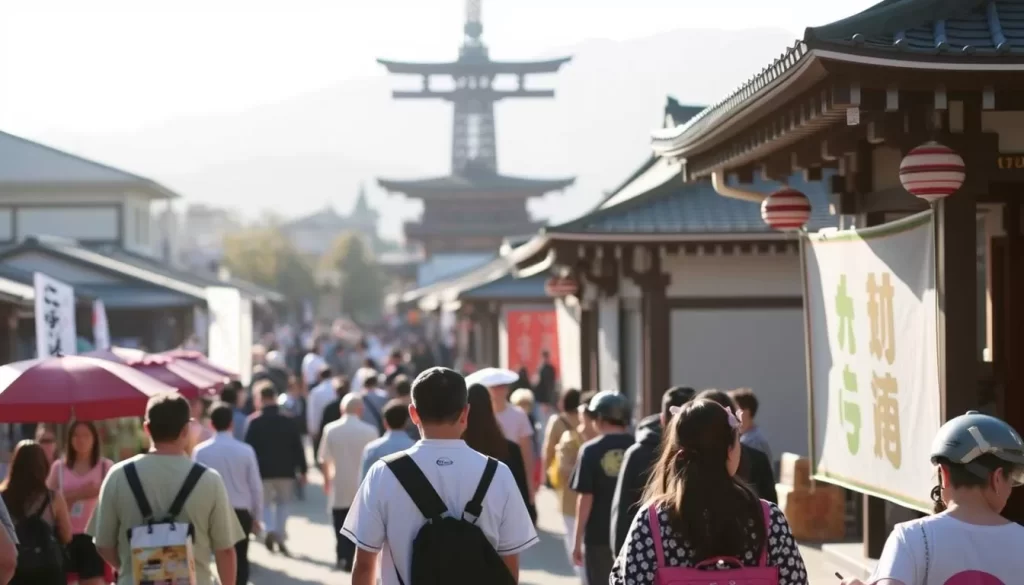
Attending a festival in Kyoto can be a life-changing experience, and with the right guidance, you can navigate the crowds and chaos with ease. To make the most of your trip to Kyoto, it’s crucial to be prepared for the unique challenges that come with attending a major festival event.
Best Viewing Spots and Photography Tips
To capture the best moments of Kyoto’s festival events, you need to know the best viewing spots. For festivals like the Jidai Matsuri or Aoi Matsuri, arrive at viewing locations at least 1-2 hours early to secure good spots, especially if you want to set up a tripod or secure seating. Popular spots often get crowded quickly, so plan your time wisely to get the best shots.
Consider visiting the Kyoto City Official Tourism Website for information on the best viewing spots and any specific photography restrictions.
Festival Etiquette and Cultural Considerations
When attending a festival in Kyoto, it’s essential to respect local customs and traditions. Dress modestly when visiting temples or shrines, and be mindful of your behavior during processions and ceremonies. Be prepared to follow instructions from local authorities and festival staff to ensure a smooth experience for everyone involved.
Understanding and respecting these cultural nuances will enhance your overall travel experience and allow you to fully immerse yourself in the local culture.
Accommodation and Transportation During Festival Seasons
Booking your accommodation well in advance is crucial, especially for major festivals like the Gion Matsuri in July and cherry blossom season in late March to early April. Consider staying in neighboring areas like Osaka if Kyoto’s hotels are fully booked or too expensive. Additionally, plan ahead for transportation, as public transportation becomes extremely crowded during major events. Check for special festival bus routes and temporary traffic restrictions to avoid any inconvenience during your trip.
You’ll find that many people visit Kyoto during festival seasons, so it’s a good idea to plan your itinerary accordingly and stay flexible.
Conclusion: Embracing the Festival Spirit of Kyoto
Embracing the festival spirit of Kyoto means diving into a world of ancient traditions and community celebrations that transform your travel experience. The city’s numerous festivals and events offer unparalleled windows into Japan’s cultural soul.
These vibrant events represent the living heart of Kyoto, where history is actively celebrated through community participation. You’ll find that timing your trip to coincide with even one of these festivals can add extraordinary depth to your Kyoto experience, connecting you with the city’s heritage in meaningful ways.
As you plan your journey, consider how Kyoto’s culture and spirit might become part of your own story. The events and celebrations in Kyoto demonstrate how cultural traditions remain vibrant and significant in contemporary Japan, making your visit a memorable one at any time.
The above is subject to change.
Check back often to TRAVEL.COM for the latest travel tips and deals.
